The Post Office P6702 form, officially designated as Form P6702 Edition 7 E September, 2001, serves as the operation and maintenance manual for the Model 326 Heavy Duty Cut-Off Tool, a device crafted primarily for exhaust system replacement tasks. This comprehensive manual not only guides users through the tool's basic operation, including specifications like its optimal air pressure and hose size for safety and peak performance, but it also emphasizes the critical importance of adhering to the enclosed safety information before tool operation. The responsibility of familiarizing operators with this manual rests on the employer, underscoring the manual's essential role in preventing injuries during use. This document outlines specific warnings, such as the need for eye and hearing protection, the dangers of damaged or improper hoses and fittings, and the tool's incompatibility with flammable lubricants. Additionally, the manual provides detailed instruction on the tool's lubrication requirements and the necessary steps for maintaining clean, dry air supply, all while cautioning against the use of non-Ingersoll-Rand replacement parts to avoid safety hazards, diminished tool performance, and potential warranty invalidation. Through this manual, Ingersoll-Rand aims to ensure that both new and experienced users of the Model 326 Cut-Off Tool can achieve top performance safely and efficiently.
| Question | Answer |
|---|---|
| Form Name | Post Office Form P6702 |
| Form Length | 12 pages |
| Fillable? | No |
| Fillable fields | 0 |
| Avg. time to fill out | 3 min |
| Other names | p6703, post office form p6702, post office card account closure form, p6703 account closure form |
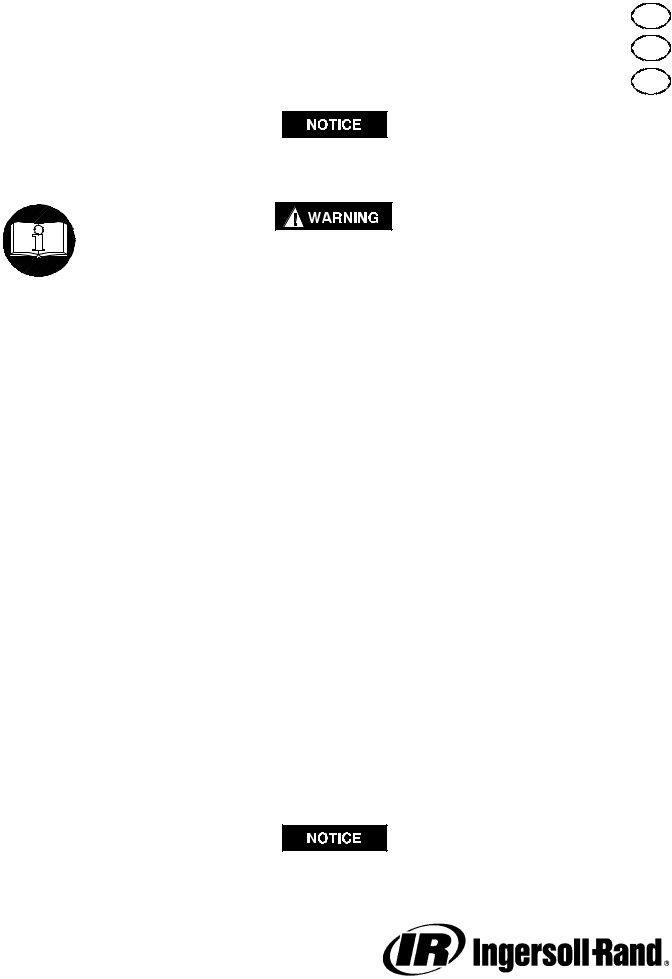
03533593 |
F |
|
Form P6702 |
||
|
||
Edition 7 |
E |
|
September, 2001 |
||
OPERATION AND MAINTENANCE MANUAL |
P |
|
FOR MODEL 326 HEAVY DUTY |
|
The Model 326
IMPORTANT SAFETY INFORMATION ENCLOSED. READ THIS MANUAL BEFORE OPERATING TOOL.
IT IS THE RESPONSIBILITY OF THE EMPLOYER TO PLACE THE INFORMATION
IN THIS MANUAL INTO THE HANDS OF THE OPERATOR.
FAILURE TO OBSERVE THE FOLLOWING WARNINGS COULD RESULT IN INJURY.
PLACING TOOL IN SERVICE
•Always operate, inspect and maintain this tool in accordance with American National Standards Institute Safety Code for Portable Air Tools (ANSI B186.1).
•For safety, top performance, and maximum durability of parts, operate this tool at 90 psig
(6.2 bar/620 kPa) maximum air pressure at the inlet with 5/16” (8 mm) inside diameter air supply hose.
•Always turn off the air supply and disconnect the air supply hose before installing, removing or adjusting any accessory on this tool, or before performing any maintenance on this tool.
•Do not use damaged, frayed or deteriorated air hoses and fittings.
•Be sure all hoses and fittings are the correct size and are tightly secured. See Dwg.
•Keep clear of whipping air hoses. Shut off the compressed air before approaching a whipping air hose.
•Always use clean, dry air at 90 psig maximum air pressure. Dust, corrosive fumes and/or excessive moisture can ruin the motor of an air tool.
•Do not lubricate tools with flammable or volatile liquids such as kerosene, diesel or jet fuel.
•Do not remove any labels. Replace any damaged label.
USING THE TOOL
•Always wear eye protection when operating or performing maintenance on this tool.
•Always wear hearing protection when operating this tool.
•Keep hands, loose clothing, long hair and jewelry away from rotating end of tool.
•Keep body stance balanced and firm. Do not overreach when operating this tool. Anticipate and be alert for sudden changes in motion, reaction torques, or forces during
•Tool shaft may continue to oscilate briefly after throttle is released.
•Air powered tools can vibrate in use. Vibration, repetitive motions or uncomfortable positions may be harmful to your hands and arms. Stop using any tool if discomfort, tingling feeling or pain occurs. Seek medical advice before resuming use.
•Use accessories recommended by
•This tool is not designed for working in explosive atmospheres.
•This tool is not insulated against electric shock.
•Do not operate tool without the
•Prevent exposure and breathing of harmful dust and particles created by power tool use:
Some dust created by power sanding, sawing, grinding, drilling and other construction activities contains chemicals known to cause cancer, birth defects or other reproductive harm. Some examples of these chemicals are:
-lead from lead based paints,
-crystalline silica from bricks and cement and other masonry products, and
-arsenic and chromium from chemically
treated lumber.
Your risk from these exposures varies, depending on how often you do this type of work. To reduce your exposure to these chemicals: work in a well ventilated area, and work with approved safety equipment, such as those dust masks that are specially designed to filter out microscopic particles.
The use of other than genuine
Repairs should be made only by authorized trained personnel. Consult your nearest
Refer All Communications to the Nearest
PRINTED IN U.S.A.
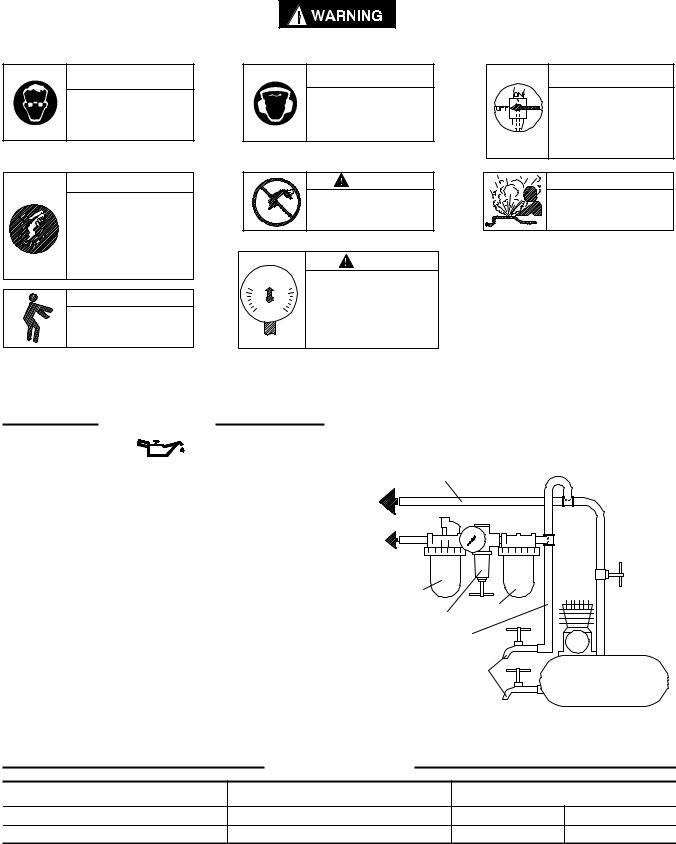
WARNING SYMBOL IDENTIFICATION
FAILURE TO OBSERVE THE FOLLOWING WARNINGS COULD RESULT IN INJURY.
WARNING
Always wear eye protection when operating or perform- ing maintenance on this tool.
WARNING
Always wear hearing protection when operating this tool.
WARNING
Always turn off the air sup- ply and disconnect the air supply hose before install- ing, removing or adjusting any accessory on this tool, or before performing any maintenance on this tool.
WARNING
Air powered tools can vibrate in use. Vibration, repetitive motions or uncomfortable po- sitions may be harmful to your hands and arms. Stop using any tool if discomfort, tingling feeling or pain occurs. Seek medical advice before resum- ing use.
WARNING
Keep body stance balanced and firm. Do not overreach when operating this tool.
|
WARNING |
|
|
Do not carry the tool by the |
|
|
hose. |
|
90 psig |
WARNING |
|
Operate at 90 psig (6.2 bar/ |
||
(6.2bar/620kPa) |
||
620 kPa) Maximum air pres- |
||
|
||
|
sure. |
WARNING
Do not use damaged, frayed or deteriorated air hoses and fittings.
PLACING TOOL IN SERVICE
LUBRICATION
MAIN LINES 3 TIMES AIR TOOL INLET SIZE
Always use an air line lubricator with this tool.
We recommend the following
For USA - No.
After each eight hours of operation, unless an
TO
AIR
SYSTEM
TO
AIR
TOOL
LUBRICATOR
REGULATOR
FILTER
Oil into the Regulator Assembly (9) before attaching the hose.
BRANCH LINE 2 TIMES AIR TOOL INLET SIZE
DRAIN REGULARLY
|
|
|
COMPRESSOR |
|
|
|
(Dwg. |
|
SPECIFICATIONS |
|
|
Model |
Free Speed, rpm |
Wheel Diameter |
|
|
|
in |
mm |
326 |
20,000 |
73 |
|
2
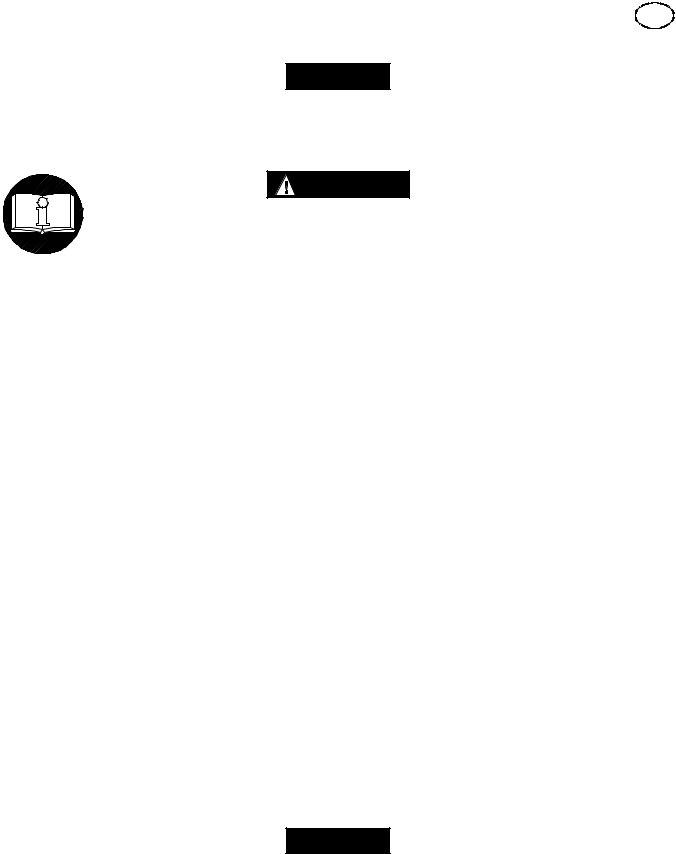
MANUEL D’EXPLOITATION ET D’ENTRETIEN
F
POUR LA TRONÇONNEUSE SÉRIE FORTE MODÈLE 326
NOTE
La tronçonneuse Modèle 326 est destinée aux travaux de remplacement de pots d’échappement. Elle coupe rapidement les silencieux, les tuyaux d’échappement, les tôles, les écrous et les boulons.
ATTENTION
D’IMPORTANTES INFORMATIONS DE SÉCURITÉ SONT JOINTES.
LIRE CE MANUEL AVANT D’UTILISER L’OUTIL.
L’EMPLOYEUR EST TENU DE COMMUNIQUER LES INFORMATIONS
DE CE MANUEL AUX EMPLOYÉS UTILISANT CET OUTIL.
LE NON RESPECT DES AVERTISSEMENTS SUIVANTS PEUT CAUSER DES BLESSURES.
MISE EN SERVICE DE L’OUTIL |
soudains de mouvement, couples de réaction ou forces |
|
• Toujours exploiter, inspecter et entretenir cet outil |
lors du démarrage et de l’exploitation. |
|
conformément au Code de sécurité des outils |
• L’oscillation des accessoires de l’outil peut continuer |
|
pneumatiques portatifs de l’American National |
pendant un certain temps après le relâchement de la |
|
Standards Institute (ANSI B186.1). |
gâchette. |
|
• Pour la sécurité, les performances optimales et la |
• Les outils pneumatiques peuvent vibrer pendant |
|
durabilité maximale des pièces, cet outil doit être |
l’exploitation. Les vibrations, les mouvements |
|
connecté à une alimentation d’air comprimé de |
répétitifs et les positions inconfortables peuvent |
|
6,2 bar (620 kPa) maximum à l’entrée, avec un |
causer des douleurs dans les mains et les bras. |
|
flexible de 8 mm de diamètre intérieur. |
N’utiliser plus d’outils en cas d’inconfort, de |
|
• Couper toujours l’alimentation d’air comprimé et |
picotements ou de douleurs. Consulter un médecin |
|
débrancher le flexible d’alimentation avant |
avant de recommencer à utiliser l’outil. |
|
d’installer, déposer ou ajuster tout accessoire sur cet |
• Utiliser les accessoires recommandés par |
|
outil, ou d’entreprendre une opération d’entretien |
||
quelconque sur l’outil. |
• Cet outil n’est pas conçu pour fonctionner dans des |
|
• Ne pas utiliser des flexibles ou des raccords |
atmosphères explosives. |
|
endommagés, effilochés ou détériorés. |
• Cet outil n’est pas isolé contre les chocs électriques. |
|
• S’assurer que tous les flexibles et les raccords sont |
• Ne jamais exploiter cet outil sans l’écran |
|
correctement dimensionnés et bien serrés. Voir Plan |
||
• Evitez toute exposition et respiration des poussières et |
||
tuyauteries. |
particules nocives créées par l’emploi de l’outil |
|
• En cas de rupture ou d’éclatement du flexible d’air ne |
pneumatique: |
|
pas s’approcher. Couper le réseau d’air comprimé |
Certaines poussières produites par les opérations |
|
avant d’approcher du flexible d’air. |
de ponçage, sciage, meulage, perçage et autres |
|
• Utiliser toujours de l’air sec et propre à une pression |
activités de construction contiennent des produits |
|
maximum de 6,2 bar. La poussière, les fumées |
chimiques qui sont reconnus comme pouvant |
|
corrosives et/ou une humidité excessive peuvent |
causer le cancer, des infirmités de naissance ou |
|
endommager le moteur d’un outil pneumatique. |
d’autres risques à effets nocifs. Parmi ces |
|
• Ne jamais lubrifier les outils avec des liquides |
produits chimiques on trouve: |
|
inflammables ou volatiles tels que le kérosène, le gasol |
- le plomb des peintures à base de plomb, |
|
ou le carburant d’aviation. |
- les cristaux de silice contenus dans les |
|
• Ne retirer aucune étiquette. Remplacer toute étiquette |
briques, le ciment et d’autres produits de |
|
endommagée. |
maçonnerie, et |
|
UTILISATION DE L’OUTIL |
- l’arsenic et le chrome des bois traités |
|
• Porter toujours des lunettes de protection pendant |
chimiquement. |
|
Le risque présenté par l’exposition à ces |
||
l’utilisation et l’entretien de cet outil. |
||
poussières est fonction de la fréquence et du type |
||
• Porter toujours une protection acoustique pendant |
||
de travail effectué. Pour réduire l’exposition à ces |
||
l’utilisation de cet outil. |
||
produits chimiques : travaillez dans une zone |
||
• Gardez les mains, vêtements amples, cheveux longs et |
||
bien aérée, et utilisez les équipements de sécurité |
||
bijoux éloignés de l’extrémité rotative de l’outil. |
||
approuvés, tels que les masques à poussière qui |
||
• Garder une position équilibrée et ferme. Ne pas se |
||
sont spécialement conçus pour filtrer et arrêter |
||
pencher trop en avant pendant l’utilisation de cet |
||
les particules microscopiques. |
||
outil. Anticiper et prendre garde aux changements |
||
|
NOTE
L’utilisation de rechanges autres que les pièces d’origine
Les réparations ne doivent être effectuées que par des réparateurs qualifiés autorisés. Consultez votre Centre de Service
Adressez toutes vos communications au Bureau
Imprimé aux É.U.
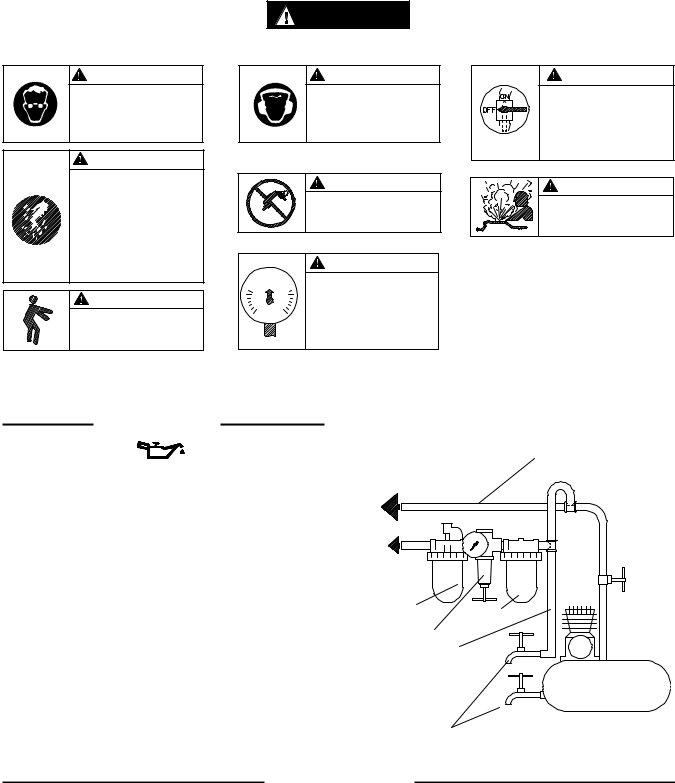
SIGNIFICATION DES SYMBOLES D’AVERTISSEMENT
ATTENTION
LE NON RESPECT DES AVERTISSEMENTS SUIVANTS PEUT CAUSER DES BLESSURES.
ATTENTION
Porter toujours des lunettes de protection pendant l’utilisation et l’entretien de cet outil.
ATTENTION
Les outils pneumatiques peuvent vibrer pendant l’exploitation. Les vibrations, les mouvements répétitifs et les positions inconfortables peuvent causer des douleurs dans les mains et les bras. N’utiliser plus d’outils en cas d’in- confort, de picotements ou
de douleurs. Consulter un médecin avant de recommencer à utiliser l’outil.
ATTENTION
Garder une position équilibrée et ferme. Ne pas se pencher trop en avant pendant l’utilisation de cet outil.
ATTENTION
Porter toujours une protection acoustique pen- dant l’utilisation de cet outil.
ATTENTION |
Ne pas transporter l’outil |
par son flexible. |
ATTENTION
90psig
(6.2bar/620kPa)
Utiliser de l’air comprimé
àune pression maximum de 6,2 bar (620 kPa).
ATTENTION
Couper toujours l’alimentation d’air comprimé et débrancher le flexible d’alimentation avant d’installer, déposer ou ajuster tout accessoire sur cet outil, ou d’entreprendre une opération d’entretien quelconque sur l’ou- til.
ATTENTION
Ne pas utiliser des flexibles ou des raccords endommagés, ef- filochés ou détériorés.
MISE EN SERVICE DE L’OUTIL
LUBRIFICATION
TUYAUTERIE PRINCIPALE AU
MOINS 3 FOIS LA DIMEN-
SION DE L’ADMISSION D’AIR
VERS LEDE L’OUTIL RÉSEAU D’AIR
COMPRIMÉ
Utiliser toujours un lubrificateur avec cet outil. Nous recommandons l’emploi du
É.U. - No.
Toutes les huit heures de fonctionnement, sauf si un lubrificateur d’air comprimé est utilisé, injecter 1/2 cm3 d’huile
(9) avant de connecter le flexible.
VERS
L’OUTIL
PNEU-
MATIQUE
LUBRIFICATEUR FILTRE
RÉGULATEUR
LIGNE SECONDAIRE AU MOINS 2 FOIS LA DIMEN- SION DE L’ADMISSION D’AIR DE L’OUTIL
VIDANGER
RÉGULIÈREMENT
COMPRESSEUR
(Plan
SPÉCIFICATIONS
Modèle |
Vitesse Libre |
Diamètre de la meule |
|
|
|
|
|
|
|
in |
mm |
|
|
|
|
326 |
20.000 |
73 |
|
|
|
|
|
4

MANUAL DE USO Y MANTENIMIENTO PARA LA HERRAMIENTA DE |
|
CORTE SERVICIO PESADO MODELO 326 |
E |
NOTA |
|
La herramienta de corte modelo 326 está diseñada para trabajos de sustitución de sistemas de escape. Corta rápidamente los silenciadores, tubos de salida, chapa, tuercas y tornillos.
AVISO
SE ADJUNTA INFORMACIÓN IMPORTANTE DE SEGURIDAD.
LEA ESTE MANUAL ANTES DE USAR LA HERRAMIENTA.
ES RESPONSABILIDAD DE LA EMPRESA ASEGURARSE DE QUE EL OPERARIO
ESTÉ AL TANTO DE LA INFORMACIÓN QUE CONTIENE ESTE MANUAL.
EL HACER CASO OMISO DE LOS AVISOS SIGUIENTES PODRÍA OCASIONAR LESIONES.
PARA PONER LA HERRAMIENTA EN SERVICIO
•Utilice, examine y mantenga siempre esta herramienta conforme al código de seguridad para herramientas neumáticas portátiles de la American National Standards Institute (ANSI B186.1).
•Para mayor seguridad, rendimiento óptimo y larga vida útil de las piezas, utilice esta herramienta a una presión de aire máxima de 90 psig (6,2 bar/
620 kPa) con una manguera de suministro de aire con diámetro interno de 8 mm.
•Corte siempre el suministro de aire y desconecte la manguera de suministro de aire antes de instalar, desmontar o ajustar cualquier accesorio de esta herramienta, o antes de realizar cualquier operación de mantenimiento de la misma.
•No utilice mangueras de aire y racores dañados, desgastados ni deteriorados.
•Asegúrese de que todos los racores y mangueras sean del tamaño correcto y estén bien apretados.
El Esq.
•Manténgase apartado de toda manguera de aire que esté dando latigazos. Apague el compresor de aire antes de acercarse a una manguera de aire que esté dando latigazos.
•Use siempre aire limpio y seco a una presión máxima de 90 psig (6,2 bar/620 kPa). El polvo, los gases corrosivos y el exceso de humedad pueden estropear el motor de una herramienta neumática.
•No lubrique las herramientas con líquidos inflamables o volátiles tales como queroseno, gasoil o combustible para motores a reacción.
•No saque ninguna etiqueta. Sustituya toda etiqueta dañada.
UTILIZACIÓN DE LA HERRAMIENTA
•Use siempre protección ocular cuando utilice esta herramienta o realice operaciones de mantenimiento en la misma.
•Use siempre protección para los oídos cuando utilice esta herramienta.
•Mantenga las manos, la ropa suelta, el cabello largo y las alhajas apartados del extremo giratorio de la herramienta.
•Mantenga una postura del cuerpo equilibrada y firme. No estire demasiado los brazos al manejar la herramienta. Anticipe y esté atento a los cambios repentinos en el movimiento, pares de reacción u otras fuerzas durante la puesta en marcha y utilización.
•El vástago puede continuar oscilando después de haberse soltado el estrangulador.
•Las herramientas neumáticas pueden vibrar durante el uso. La vibración, los movimientos repetitivos y las posiciones incómodas pueden dañarle los brazos y manos. En caso de incomodidad, sensación de hormigueo o dolor, deje de usar la herramienta. Consulte con el médico antes de volver a utilizarla.
•Utilice únicamente los accesorios recomendados por
•Esta herramienta no ha sido diseñada para trabajar en ambientes explosivos.
•Esta herramienta no está aislada contra descargas eléctricas.
•No utilice esta herramienta sin que tenga instalado el protector antichispas de acero de
•Evite respirar el polvo y partículas nocivos que se producen al utilizar la herramienta, así como exponerse a ellos:
Ciertos tipos de polvo que se producen al lijar, serruchar, rectificar o taladrar y durante otras actividades de la construcción contienen sustancias químicas que son conocidos como causantes de cáncer, defectos de nacimiento y otros daños reproductivos. Algunos ejemplos de estas sustancias químicas:
-el plomo de las pinturas con base de plomo,
-la sílice cristalina de ladrillos y hormigón y otros productos asociados con la albañilería, y
-el arsénico y el cromo que produce la madera
sometida a tratamientos químicos.
El riesgo a la persona que presenta una exposición de este tipo varia en función de la frecuencia con que se realiza esta clase de trabajo. Para reducir la exposición a estas sustancias químicas: trabaje en una zona bien ventilada y utilice equipo de protección homologado, por ejemplo una mascarilla especialmente diseñada para filtrar partículas microscópicas.
NOTA
El uso de piezas de recambio que no sean las auténticas piezas
Las reparaciones sólo se deben encomendar a personal debidamente cualificadoy autorizado. Consulte con el centro de servicio autorizado
Toda comunicación se deberá dirigir a la oficina o al distribuidor
Impreso en EE. UU.

IDENTIFICACIÓN DE SÍMBOLOS DE AVISO
AVISO
EL HACER CASO OMISO DE LOS AVISOS SIGUIENTES PODRÍA OCASIONAR
LESIONES.
ADVERTENCIA
Use siempre protección ocular cuando utilice esta herramienta o realice operaciones de mantenimiento en la misma.
ADVERTENCIA
Las herramientas neumáticas pueden vibrar durante el uso. La vibración, los movimientos repetitivos o las posiciones incómodas podrían dañarle los brazos y las manos. En caso de incomodidad, sensación de hormigueo o dolor, dejar de usar la herramienta. Consultar al médico antes de volver a uti- lizarla.
ADVERTENCIA
Mantener una postura del cuerpo equilibrada y firme. No estirar de- masiado los brazos al manejar la herramienta.
ADVERTENCIA
Use siempre protección para los oídos cuando utilice esta herramienta.
ADVERTENCIA
No coger la herramienta por la manguera para le- vantarla.
ADVERTENCIA
90psig
(6.2bar/620kPa)
Manejar la herramienta a una presión de aire máxima de 90 psig (6,2 bar/620 kPa).
ADVERTENCIA
Cortar siempre el suministro de aire y desconectar la man- guera de suministro de aire antes de instalar, retirar o ajus- tar cualquier accesorio de esta herramienta, o antes de reali- zar cualquier operación de mantenimiento de la misma.
ADVERTENCIA
No utilizar mangueras de aire
yaccesorios dañados, des- gastados ni deteriorados.
PARA PONER LA HERRAMIENTA EN SERVICIO
LUBRICACIÓN |
TUBERÍAS PRINCIPALES 3 |
|
VECES EL TAMAÑO DE |
|
ENTRADA DE HERRAMIENTA |
AL SISTEMA |
NEUMÁTICA |
NEUMÁTICO |
|
Use siempre un lubricante de aire con esta herramienta. Recomendamos el siguiente conjunto de
EE. UU. - No.
Después de cada ocho horas de funcionamiento, a menos que se use un lubricador de línea de aire, inyecte 1/2 cc de aceite
ALA
MIENTA NEUMÁTICA
LUBRICADOR
REGULADOR
TUBERÍA DE RAMAL 2 VECES EL TAMAÑO DE ENTRADA DE
FILTRO
antes de acoplar la manguera.
HERRAMIENTACOMPRESOR NEUMÁTICA
PURGAR
PERIÓDICAMENTE
(Esq.
ESPECIFICACIONES
Modelo |
Velocidad en Vacio |
Diámetro de la rueda |
|
|
|
|
|
|
|
in |
mm |
|
|
|
|
326 |
20.000 |
73 |
|
6
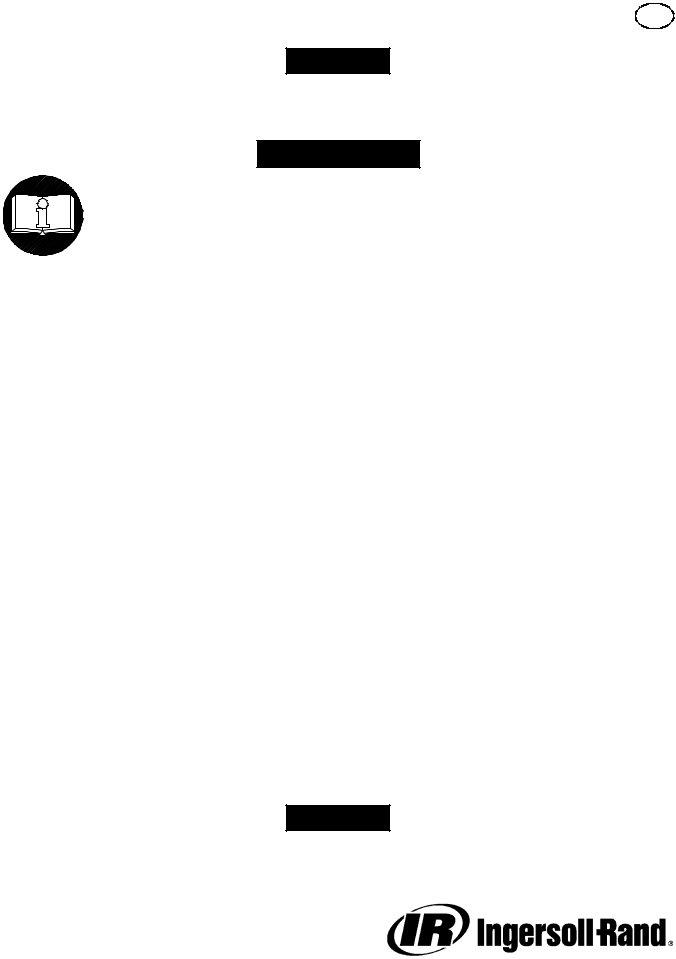
MANUAL DE FUNCIONAMENTO E MANUTENÇÃO
PARA A MÁQUINA DE DISCO DE CORTE PARA P TRABALHO PESADO MODELO 326
AVISO
A Máquina de Disco de Corte Modelo 326 é concebida para tarefas de substituição de sistemas de escape. Corta rapidamente silenciosos, tubos de escape, chapas metálicas, porcas e parafusos.
A
ADVERTÊNCIA
INFORMAÇÃO DE SEGURANÇA IMPORTANTE EM ANEXO.
LEIA ESTE MANUAL ANTES DE OPERAR A FERRAMENTA.
ÉDA RESPONSABILIDADE DO EMPREGADORCOLOCAR A INFORMAÇÃO DESTE MANUAL NAS MÃOS DO OPERADOR.
O NÃO CUMPRIMENTO DAS SEGUINTES ADVERTÊNCIAS PODE
RESULTAR EM FERIMENTOS.
COLOCANDO A FERRAMENTA EM FUNCIONAMENTO
•Sempre opere, inspeccione e mantenha esta ferramenta de acordo com o Código de Segurança do Instituto Americano de Padrões Nacionais para Ferramentas Pneumáticas Portáteis (ANSI B186.1).
•Para segurança, máximo desempenho e máxima durabilidade das peças, opere esta ferramenta com uma pressão de ar máxima de 6,2 bar/620 kPa
(90 psig) na entrada da mangueira de alimentação de ar com diâmetro interno de 8 mm (5/16”).
•Desligue sempre a alimentação de ar e desconecte a mangueira de alimentação de ar antes de instalar, remover ou ajustar qualquer acessório nesta ferramenta, ou antes de executar qualquer serviço de manutenção nesta ferramenta.
•Não use mangueiras de ar ou adaptadores danificados, gastos ou deteriorados.
•
•
•Use sempre ar seco e limpo com pressão máxima de 90 psig. Pó, fumos corrosivos e/ou humidade excessiva podem arruinar o motor de uma ferramenta pneumática.
•Não lubrifique as ferramentas com líquidos inflamáveis ou voláteis tais como querosene, diesel ou combustível de jactos.
•Não remova nenhum rótulo. Reponha qualquer rótulo danificado.
USANDO A FERRAMENTA
•Use sempre óculos de protecção quando estiver operando ou executando serviço de manutenção nesta ferramenta.
•Use sempre protecção contra ruído ao operar esta ferramenta.
•Mantenha as mãos, roupas soltas, cabelos longos e jóias afastados da extremidade rotativa da ferramenta.
•Mantenha o corpo numa posição equilibrada e firme. Não estique o corpo ao operar esta ferramenta. Esteja preparado e alerta para mudanças súbitas no movimento, binários ou forças de reacção durante o arranque e o funcionamento.
•O eixo da ferramenta pode continuar a girar brevemente após a pressão ter sido aliviada.
•Ferramentas accionadas pneumáticamente podem vibrar em uso. Vibração, movimentos repetitivos ou posições desconfortáveis podem ser prejudiciais às mãos e aos braços. Pare de usar a ferramenta caso ocorra algum desconforto, sensação de formigueiro ou dor. Procure assistência médica antes de retornar ao trabalho.
•Use acessórios recomendados pela
•Esta Ferramenta não foi concebida para trabalhos em atmosferas explosivas.
•Esta Ferramenta não está isolada contra choques eléctricos.
•Não opere esta ferramenta sem a Proteção em Aço contra Faíscas da
•Evite
Algumas poeiras criadas por operações motorizadas de lixar, serrar, rectificar, perfurar e outras actividades de construção contêm produtos químicos conhecidos por causarem cancro, malformações congénitas e terem efeitos nocivos na reprodução. Alguns exemplos desses produtos químicos são:
-chumbo de tintas à base de chumbo,
-sílica cristalina de tijolos e cimento e outros produtos de alvenaria e
-arsénico e crómio de madeira tratada
quimicamente
Os riscos dessas exposições varia, dependendo de com que frequência faz esse tipo de trabalho. Para reduzir a sua exposição a esses produtos químicos: trabalhe numa área bem ventilada e com equipamento de segurança aprovado, como as máscaras contra a poeira que são especialmente projectadas para filtrar partículas microscópicas.
AVISO
O uso de peças de substituição que não sejam genuinamente da
As reparações devem ser feitas somente por pessoal treinado autorizado. Consulte o Centro de Serviços da
Envie Todos os Comunicados Para o Distribuidor ou Escritório da
Impresso nos E.U.A.
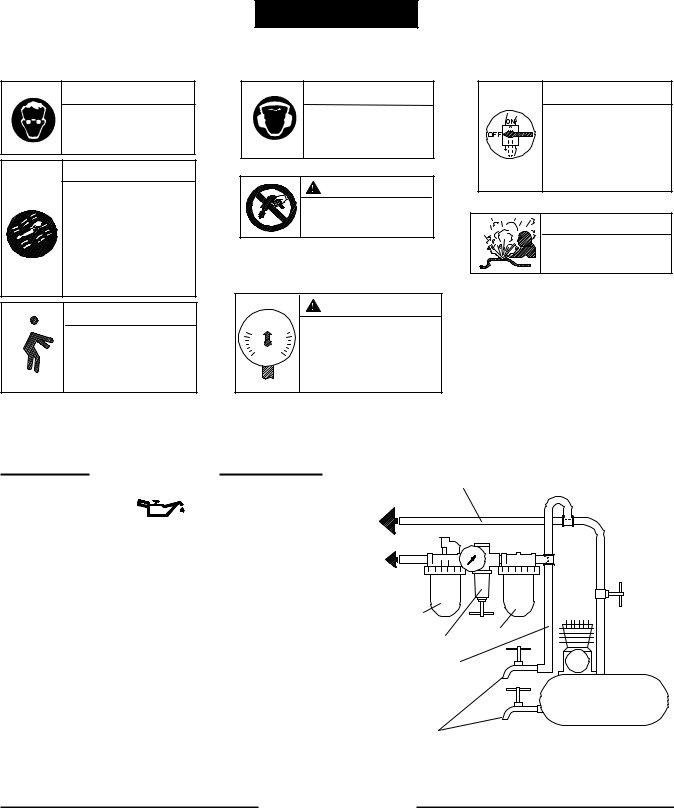
IDENTIFICAÇÃO DO SÍMBOLO DE AVISO
ADVERTÊNCIA
O NÃO CUMPRIMENTO DAS SEGUINTES ADVERTÊNCIAS PODE
RESULTAR EM FERIMENTOS.
ADVERTÊNCIA
Use sempre óculos de protecção quando estiver operando ou executando algum serviço de manutenção nesta ferramenta.
ADVERTÊNCIA
Ferramentas accionadas pneumáticamente podem vibrar em uso. Vibração, movimentos repetitivos ou posições desconfortáveis podem ser prejudiciais às mãos e aos braços. Pare de usar a ferramenta caso ocorra algum desconforto, sensação de formigueiro ou dor. Procure assistência médica antes de retornar ao trabalho.
ADVERTÊNCIA
Mantenha a posição do corpo equilibrada e firme. Não exagere quando operar esta ferramenta. Torques de reacção elevados podem ocorrer sob a pressão de ar recomendada.
ADVERTÊNCIA
Use sempre protecção contra o ruído ao operar esta ferramenta.
ADVERTÊNCIA |
Não carregue a ferramenta |
segurando na mangueira. |
ADVERTÊNCIA |
90 psig |
(6.2bar/620kPa) Opere com pressão do ar Máxima |
de |
ADVERTÊNCIA
Desligue sempre a alimentação de ar e desconecte a mangueira de alimentação de ar antes de instalar, remover ou ajustar qualquer acessório nesta ferramenta, ou antes de executar algum serviço de manutenção nesta ferramenta.
ADVERTÊNCIA
Não use mangueiras de ar ou adaptadores danificados, gastos ou deteriorados.
COLOCANDO A FERRAMENTA EM FUNCIONAMENTO
LUBRIFICAÇÃO
Use sempre um lubrificador de ar de linha com estas ferramentas. Nós recomendamos a seguinte unidade
E.U.A. - No.
Após cada oito horas de funcionamento, a menos que esteja a ser utilizado um lubrificador de linha de ar, injecte 1/2 cc de Óleo
LINHAS PRINCIPAIS 3 VEZES O TAMANHO DA
PARA ENTRADA DA FERRAMENTA PNEUMÁTICA SISTEMA DE AR
PARA
FERRAMENTA
PNEUMÁTICA
LUBRIFICADOR |
|
FILTRO |
|
REGULADOR |
|
LINHA RAMIFICADA |
|
2 VEZES O TAMANHO |
|
DA ENTRADA DA |
COMPRESSOR |
FERRAMENTA |
|
PNEUMÁTICA |
|
DRENE |
|
REGULARMENTE |
(Desenho |
ESPECIFICAÇÕES
Model |
Velocidade Livre |
Diâmetro da Mó |
|
|
|
|
|
|
|
in |
mm |
|
|
|
|
326 |
20.000 |
73 |
|
8
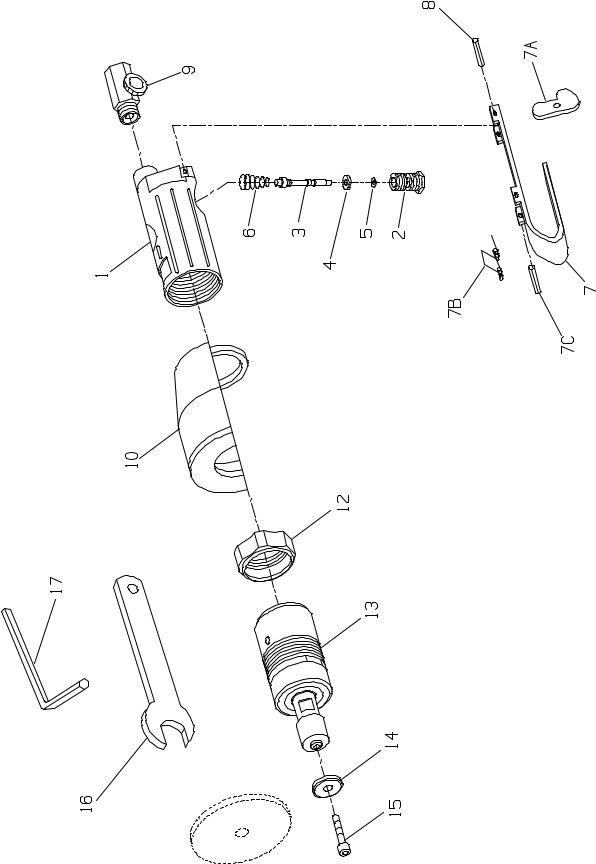
MAINTENANCE SECTION
(Dwg.
9

PART NUMBER FOR ORDERING |
PART NUMBER FOR ORDERING |
|
1 |
Motor Housing |
|
9 |
Regulator Assembly |
||
* |
Warning Label |
|
10 |
Steel Spark Shield |
||
2 |
Throttle Valve |
|
12 |
Spark Shield Lock Nut |
||
3 |
Throttle Valve Stem Assembly |
|
13 |
Motor Assembly |
||
4 |
Valve Stem Seal |
|
14 |
Wheel Flange |
||
5 |
Plunger Seal |
|
15 |
Wheel Flange Screw |
||
6 |
Throttle Valve Spring |
|
16 |
Arbor Wrench |
||
7 |
Throttle Lever Assembly |
|
17 |
Flange Screw Wrench |
||
7A |
Throttle Lever Latch |
|
* |
Nameplate |
||
7B |
Latch Spring |
|
* |
Nameplate Drive Screw (2) |
||
7C |
Latch Pin |
|
|
|
|
|
8 |
Throttle Lever Pin |
|
|
|
|
|
|
|
|
|
|
|
|
*Not illustrated.
10
MAINTENANCE SECTION

MAINTENANCE SECTION
Always wear eye protection when operating or performing maintenance on this tool.
Always turn off the air supply and disconnect the air supply hose before installing, removing or adjusting any accessory on this tool, or before performing any maintenance on this tool.
DISASSEMBLY
General Instructions
1.Do not disassemble the tool any further than necessary to replace or repair damaged parts.
2.Whenever grasping a tool or part in a vise, always use
3.Do not remove any part which is a press fit in or on a subassembly unless the removal of that part is necessary for repairs or replacement.
4.Do not disassemble the tool unless you have a complete set of new gaskets and
Disassembly of the Tool
1.Using the Arbor Wrench (16) to keep the spindle from rotating, use the Flange Screw Wrench (17) to loosen and remove the Wheel Flange Screw (15), Wheel Flange (14) and the
2.Using a wrench on the Spark Shield Lock Nut (12), loosen the Nut by rotating it counterclockwise.
3.Using a wrench on the flats located on the large body of the Motor Assembly (13), unscrew the Motor Assembly and separate it from the Motor Housing (1). Remove the Steel Spark Shield (10) and Shield Lock Nut.
4.Unscrew and remove the Power Regulator (9).
5.Press the Throttle Lever Pin (8) out of the Motor Housing and Throttle Lever Assembly (7). Remove the Throttle Lever Assembly.
6.Using a wrench on the hex of the Throttle Valve (2), unscrew the Valve and remove the Throttle Valve Stem Assembly (3) and Throttle Valve Spring (6).
ASSEMBLY
General Instructions
1.Always press on the inner ring of a
2.Always press on the outer ring of a
3.Whenever grasping a tool or part in a vise, always use
4.Always clean every part and wipe every part with a thin film of oil before installation.
5.Check every bearing for roughness. If an open bearing must be cleaned, wash it thoroughly in a clean, suitable, cleaning solution and dry with a clean cloth.
Sealed or shielded bearings should not be cleaned. Work grease into every open bearing before installation.
6.Apply a film of
Assembly of the Tool
1.Insert the Throttle Valve Spring (6), large end leading, followed by the Throttle Valve Stem Assembly (3) into the Motor Housing (1).
2.Thread the Throttle Valve (2) into the Housing and tighten it with a wrench.
3.Position the Throttle Lever Assembly (3) on the Housing and press the Throttle Lever Pin (8) into the Lever and Housing to secure the Lever in position.
4.Thread the Spark Shield Lock Nut (12) onto the Motor Assembly (13) as near to the wheel end as possible.
5.Place the Steel Spark Shield (10) on the Motor Assembly against the Lock Nut.
6.Thread the Motor Assembly into the Motor Housing and using a wrench on the motor flats, tighten the Motor in the Housing.
7.Orient the Shield to the desired position against the Motor Housing. Rotate the Lock Nut counterclockwise until it locks the Shield against the Motor Housing.
8.Install the Regulator Assembly (9) at the rear of the Motor Housing and tighten it with a wrench.
9.Install a
11

MAINTENANCE SECTION
TROUBLESHOOTING GUIDE
Trouble |
Probable Cause |
Solution |
|
|
|
Loss of power |
Low air pressure |
Check the air supply. For top performance, the air |
|
|
pressure must be 90 psig (6.2 bar/620 kPa) at the |
|
|
inlet of the tool. |
|
|
|
|
Clogged Power Regulator |
Clean the Power Regulator in a clean, suitable |
|
|
cleaning solution. If it cannot be cleaned, replace |
|
|
it. |
|
|
|
|
Worn Throttle Valve |
Replace the Throttle Valve. |
|
|
|
Leaky Throttle Valve |
Worn Throttle Valve |
Install a new Throttle Valve. |
|
|
|
Excessive runout |
Bent Arbor |
Replace the Motor Assembly. |
|
|
|
SAVE THESE INSTRUCTIONS. DO NOT DESTROY.